Agronomic Insights
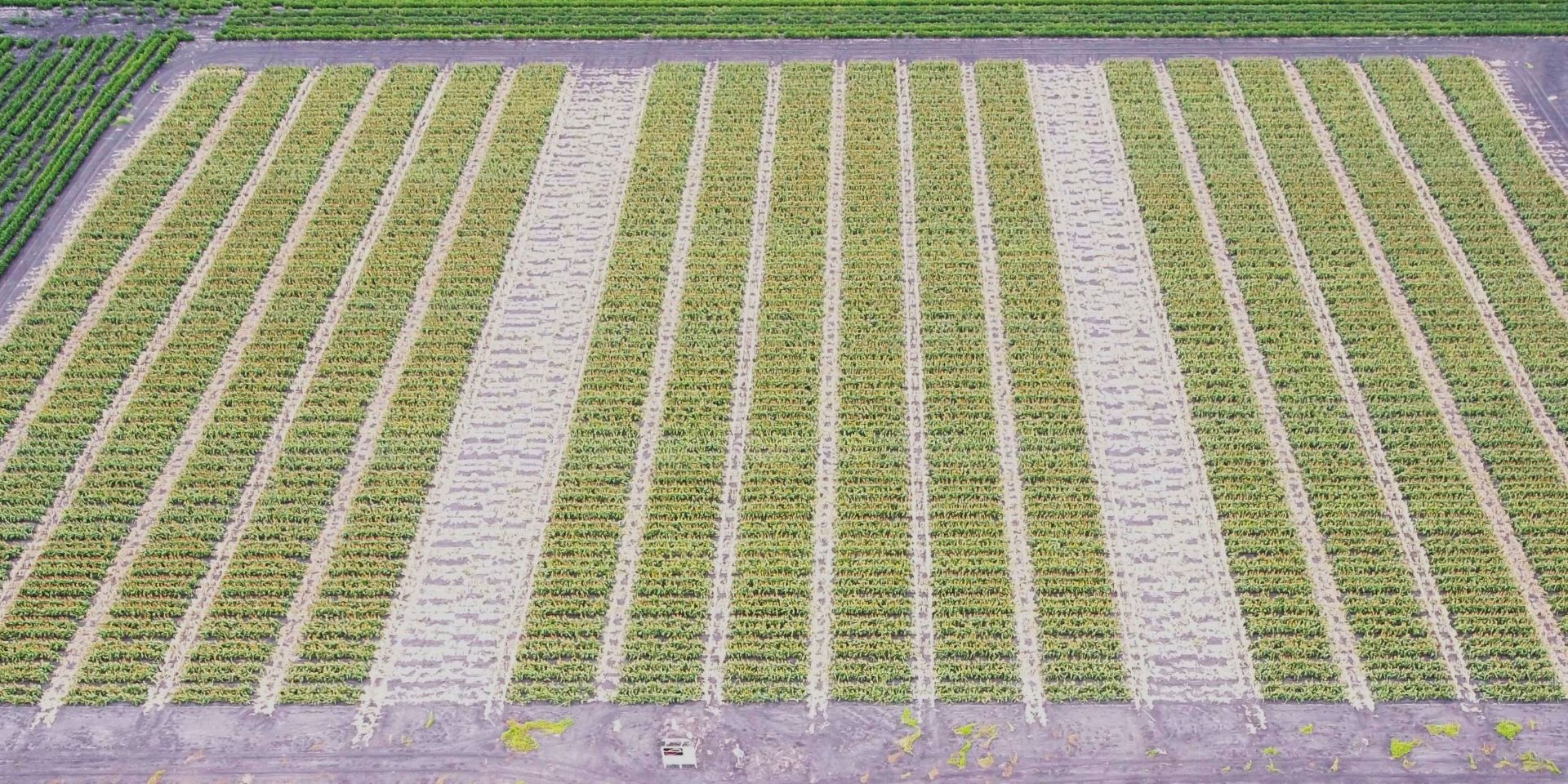
Bede O’Mara – IPF Technical Agronomist
The wetter seasons from 2020 to 2023 certainly posed some challenges for operational timeline. As a result, compromises were made to nutrition programs because of restricted paddock trafficability. It was harder to apply fertiliser when and where it was needed, so crops had to sustain themselves until nutrients could be applied (or became available). Full or near full soil moisture profiles and very low soil-nitrate levels planting led less than ideal strategies to supply nitrogen to crops – given the risk of loss and movement of applied N.
Where to from here?
Planning for the next summer crop season should always begin with soil sampling. The key is to:
- use the Fertcare guidelines (see SamplingGuide.pdf) to get the correct topsoil depth for each enterprise.
- segment profile deep soil samples to understand the position and magnitude, presence or absence of nutrients and other factors like subsoil constraints.
The sooner this sampling occurs the better, to allow ample time to respond to the recommendations provided. Understanding the intended crop species and root architecture, soil moisture, nutrients required, machinery available for applications, and the fate of the nutrients applied come planting time or peak crop demand are important considerations to devise a suitable plan A and plan B program.
Looking forward, looking back
As they say, past performance cannot reliably predict what might happen in the future, but I believe it can provide us with a range of possible outcomes. Incitec Pivot Fertilisers long-term trial site, “Colonsay”, on the QLD Darling Downs has grown 14 grain sorghum crops since 1985. Seven were following a short fallow, and seven following a long fallow. Last season, grain sorghum was planted following a forced (wet) long fallow in December 2022. This was the 34th crop planted during the 37-year experiment.
Since inception in 1985, the site has seen the nutrients nitrogen, phosphorus, and sulphur applied alone or in combination at four rates (0; 40; 80; 120 kg/ha nitrogen; 0P; 5P; 10P; 20 kg/ha phosphorus; 0; 10; 20; 30 kg/ha sulphur). Each plot has received the same rate of the same nutrients either applied pre-plant (for nitrogen and sulphur) or applied at-planting with seed (for phosphorus) for each crop.
A total of 793 mm of rainfall was received in the fallow from wheat harvest in late 2021 to sorghum planting on 7 December 2022. Growing season rainfall from sorghum planting to harvest was 196.5 mm. A total of 989 mm rainfall for the period from wheat harvest 2021 November 2022 to sorghum harvest on 14 April 2023 was recorded.
Nitrogen
Rainfall driven nitrogen losses in 2022 equalled the largest recorded in the site’s 37-year history. High N carryover post-drought (due to low cropping frequency and low crop N removal), coupled with cumulative nitrogen input applications for each crop exceeding that of grain nutrient removal in those lighter-yielding years, resulted in high nitrogen being present in the profile following wheat harvest in late 2021.
Numerous soil sample timings in 0-90 cm profile (and 90-120 cm profile not shown) over the following year (2022 into 2023) concluded that:
- nitrogen was indeed lost or moved deeper into the 90-120 cm part of the soil profile as nitrate N over the fallow period-presumably from nitrate nitrogen leaching
- the quantity of nitrogen (kgN/ha) reduced significantly over time, and ranged from 163–676 kgN/ha in January 2022 to 90–160 kgN/ha present in January 2023
- the loss (expressed as a percentage range) was 45–76% (mean 60.5%) and is similar to previous loss events recorded in percentage terms (Hall, 2011)
Despite this, the 2022-23 Grain Sorghum had 90-160kg/ha of nitrate nitrogen in the 0-90cm profile present at 30 days after planting for crop supply.
Hence, the nitrogen present was enough to sustain the modest grain sorghum yields harvested in the 2022-23 season. Pre-applied nitrogen rates, applied as urea three months prior to planting in August 2022) had little impact on grain yield.
There was no significant response from the August applied pre-plant N last season.

2022-23 grain sorghum grain protein (data not shown) was not significantly different from any of the applied nitrogen rates, where the range was 11.0-11.4%. There was no clear trend or correlation with pre-plant applied nitrogen rate. This indicates ample N was present for the yields grown.
The grain yield result in 2022-23 mirrors the long-term yield trend over 14 grain sorghum crops at this site, where the response to applied pre-plant nitrogen applications following a long fallow has generally not been significant, with either the Nil N control (0 kgN/ha) rate or 40 kgN/ha rate applied maximising grain yield.
However, when grain sorghum has been sown following short fallows or periods of high cropping frequency with lower mineralised N contributions, the general maximum grain yield responses have been from applied N rates of 80 kgN/ha or 120 kgN/ha.

N Application Timing and N Product
Like the results of Philp (2023), timing of application and product choice of N provided a positive grain yield response last season.
Timing of N application trials has been examined at the Colonsay experiment over many years, with little difference observed between banded pre-plant and banded at-sowing timings (Lester & Dowling 2001).
Product choice (BIG N vs urea) has also been trialled previously at the former IPF long-term trial site “Tulloona” in northern NSW, with no significant differences recorded (Lester & Dowling, 2001).
N Product Performance: Single Season
In 2022-23, there was a small single season sub-experiment comparing product choice established applied banded into soil approximately three weeks pre-plant using the same crescent knife opener and machine speed for each application. The number of plots available did not allow a full 3-way product comparison at all combinations of nitrogen and phosphorus.
Urea was compared to anhydrous ammonia (BIG N) and urea ammonium nitrate (UAN) (Easy N) all applied at 120 kgN/ha with no phosphorus added; then only products BIG N and Easy N at 120 kgN/ha were applied with the 10 kgP/ha and 20 kgP/ha treatments added.
Whilst there is no statistically significant grain yield difference observed between the N products, there is a trend that UAN (Easy N) provided marginally higher grain yields at each of the P rates tested.
However, the grain yield increases gained from adding phosphorus at or greater than 10 kgP/ha provided significantly higher grain yield than where no P (0 kgP/ha) was added, regardless of the N product used.
^Note the application of banded Easy N as a soil applied pre-plant banded N fertiliser is not a common use pattern nor endorsed necessarily, rather merely applied in this way to compare it to other pre-plant soil-banded products.
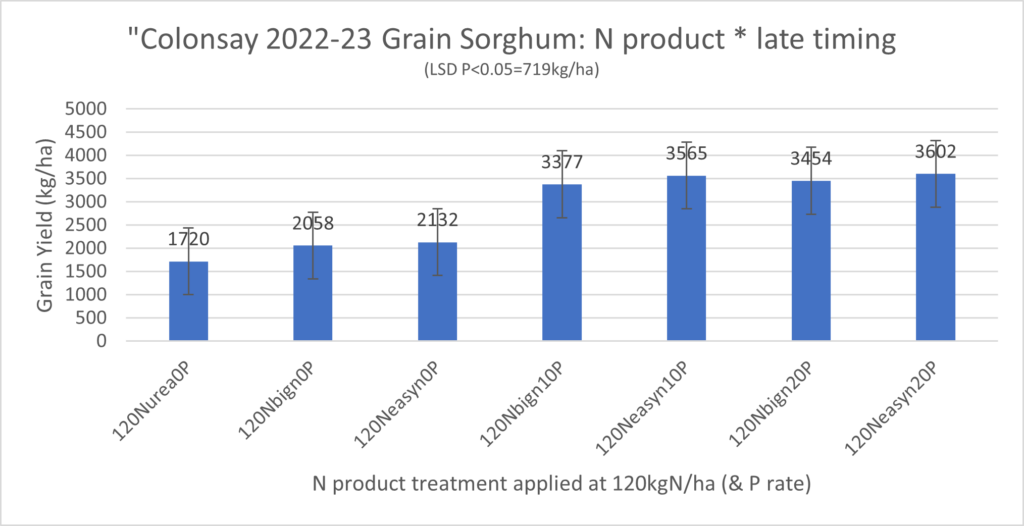
Timing
Application times deployed were August 2022 (~3 months pre-plant) and November 2022 (~3 weeks pre-plant). Presumably the 204 mm of rain experienced between the August fertiliser application and planting contributed to total profile nitrogen loss or movement from either leaching or denitrification. However, the distribution of the August-applied N (as soil nitrate measured in soil samples) appeared confined to the 0-10 cm and 10-30 cm profile zones, indicating little movement despite the post-application rainfall, as the subsoil was already particularly full.
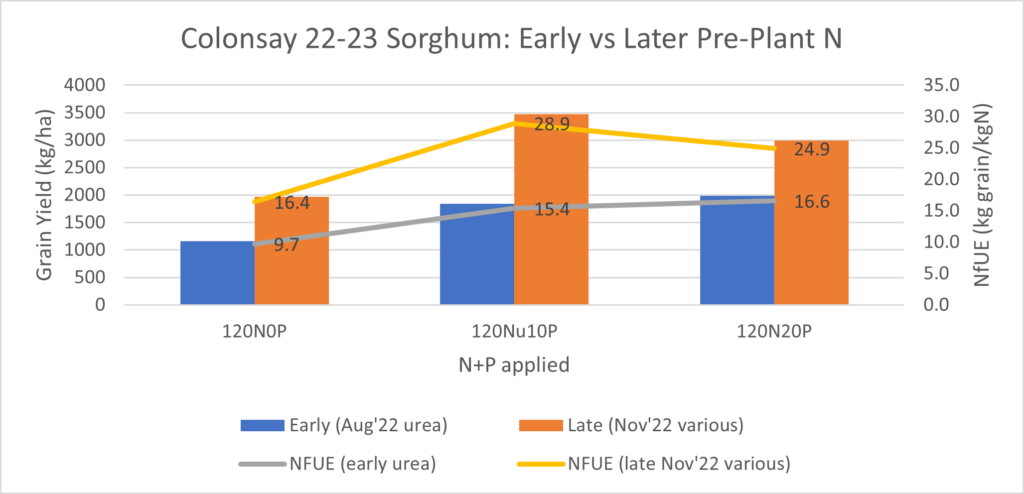
Nitrogen: Where to now?
Based on the 4Rs of nutrition stewardship (TFI, 2017), deciding on a nitrogen rate is reasonably straightforward. The 4Rs consider a site-specific yield and quality target, the crop nitrogen demand to achieve this, the preceding fallow length, and the confidence in the outcome that comes from knowing where you’re starting from. Segmented profile soil sampling is the starting point for determining the appropriate N rate. The product, timing, and placement of nitrogen (as outlined above) are based on these long-term results, less important than the nutrient supply in most seasons.
Monitor grain nutrients and grain protein
While growers don’t generally record sorghum grain protein (as it is not currently relevant to financial return) it is very useful to monitor nitrogen performance post-harvest and to accurately calculate the amount of N removed from the paddock with the grain.
The use of grain nutrient testing, such as the G1 test from the Nutrient Advantage Laboratory, is also a useful monitoring tool for monitoring grain nutrient export. Site-specific or farm-specific data is always the most accurate, so rather than relying on published data from various locations, collect, analyse and interpret your own.
The 2022-23 “Colonsay” grain sorghum crop recorded site mean grain nutrient removals of:
- 17.9 kg nitrogen (N)/mt of grain
- 4.2 kg phosphorus (P)/mt of grain
- 3.9 kg potassium (K)/mt of grain
- 1.4 kg sulphur (S)/mt of grain
- 37 grams Zinc (Zn)/mt of grain
Recording these for each nutrient and crop across rotations and cumulatively monitoring running totals can provide insights into forming a fertiliser program and assist when using some of the other useful nutrient performance indicators.
The agronomic efficiency (AE) (or nitrogen fertiliser use efficiency) is calculated by dividing grain yield (in kg/ha) by the fertiliser nitrogen rate applied, resulting in the kg of grain grown per kg of nitrogen fertiliser applied. It tends to be highest at low N application rates and decreases with an increasing N rate. The 2022-23 “Colonsay” grain sorghum crop recorded agronomic efficiencies for nitrogen of:
- 42 kg grain per kg of N applied in the 40 kg/ha N applied plots
- 20.6 kg grain per kg of N applied in the 80 kg/ha N applied
- 14.0 kg grain per kg of N applied in the 120 kg/ha N applied
Adding phosphorus in combination with these N rates increased the AE, but also tended to increase the total nitrogen removal in grain from the paddock.
The partial factor productivity (PFP) can only be calculated when a control treatment exists (a nil fertiliser or nil nutrient strip exists, such as in rate trials), so it is less useful in commercial farm operations, however, still useful to monitor nutrient performance. It is calculated by taking the treatment grain yield minus the control grain yield, then dividing that by the nitrogen rate applied, resulting in additional kg of grain grown above the control per kg of nitrogen applied. This calculation can be used when comparing your own practice (i.e. current farmer practice) to another.
eNpower results
In 2011, the dimethyl pyrazole (DMP) nitrification inhibitor, eNpower, was added as a paired sub-experiment comparing it to granular urea. Since then, there has been slightly higher nitrate-nitrogen present in the pre-plant soil samples, and a slight grain yield advantage at the lowest N rate in some seasons.
Products such as eNpower require losses to occur to show positive production or other benefits. However, numerous GHG emission studies have clearly demonstrated reductions in emissions from eNpower. A local example is presented by Bell, Lester & Grace (2014), where cumulative nitrous oxide emissions from 160 kgN (applied pre-plant as urea and as DMP-treated urea) to grain sorghum reduced by 1500 gN20/ha/day.
The 2022-23 sorghum results revealed a slight, however, not statistically significant yield increase from using eNpower (compared to untreated urea) recorded at the 40 kg nitrogen applied rate of 149 kg/ha (or 6%). No yield increases compared to urea were recorded by using eNpower at either the 80 kgN or 120 kgN rates. This compares to many other recent IPF field trials using eNpower, where yield benefits from inhibitors seem to be greatest at the lowest nitrogen rate, and the benefit declines with excessive (i.e. greater than crop uptake requirement) nitrogen rates. Yield increases in the order of 6-12% have been recorded.
Phosphorus
The long-term results from this site indicate that responses to applied P in grain sorghum following long fallow are generally significant (Lester et al, 2010), and the 2022-23 growing season certainly showed this again.

The 2022-23 season was cool and wet and following a long fallow, so responses to applied P at-planting, were likely.
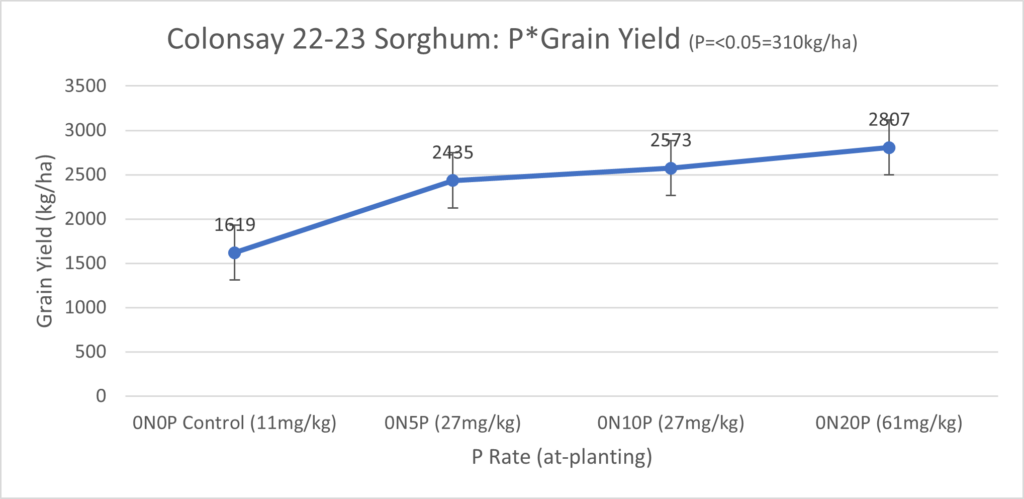
Considering fallow length, phosphorus fertiliser history coupled with Colwell P along with Phosphorus Buffer Index (PBI) are indicators of the variability and predictability we see to applied starter phosphorus. However, even modest starter P grain yield responses are more likely reflective of season, noting that biomass responses in summer crops generally do tend to translate to grain yield responses come harvest.
Sulphur
Sulphur has been added since inception of the experiment at the same pre-plant timing as the N applications, at rates of 0, 10, 20 and 30 kgS/ha applied using granulated ammonium sulphate (GranAm 20.2N; 24S). This has been blended or co-applied with urea at a single 80 kgN/ha rate, (not across all the N rates in the trial). Phosphorus at a single rate of 5 kgP/ha is also added with seed at planting to these S plots.
Lester (1999) reported grain yield responses in the 1998-99 grain sorghum crop to applied Sulphur, at the 20 and 30 kgS/ha rates, significantly greater than the 0 and 10 kgS/ha treatments and noted visual deficiency symptoms during the growing season.
The 2022-23 sulphur results (again following a wet period where sulphate-sulphur leaching had indeed occurred), showed no visual deficiency symptoms in crop, and there were no statistically significant grain yield responses from applied S.
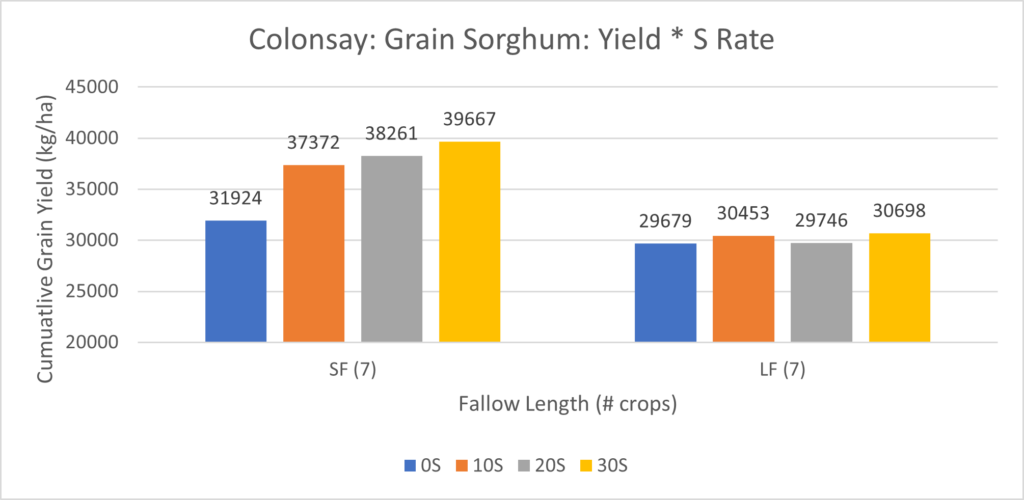
When looking at the long-term yield trend over 14 grain sorghum crops at this site, the response to applied pre-plant sulphur applications (in combination with 80N5P) following a long fallow has generally not been significant. A near flat line response, with the 30 kgS/ha rate applied maximising grain yield, with little variation or contribution from any particularly S rate above the 0 kg S/ha nil rate.
However, when grain sorghum has been sown following short fallows or periods of high cropping frequency with lower mineralised S contributions, S depletion in topsoil layers due to grain nutrient removal or movement down the profile from leaching, there is a cumulative grain yield response (in combination with 80N5P) to applied S at any rate greater than the 0 kgS/ha nil S applied rate at either 10, 20 and maxing out at 30 kgS/ha.
It must be noted that in each of these single trial site years, only one was statistically significant for applied S: the 1998-99 season, as reported by Lester (1999) in grain sorghum. The other significant result recorded from applied S was in 2017 where double crop barley sown after mungbean experienced excessive rainfall events from Tropical Cyclone Debbie.
Soil testing the topsoil and subsoil to 60 cm using the MCP S (mono-calcium phosphate) extraction method is still recognised as the best method for determining likely S responses in grain crops in the northern grains region.
Take Home Messages
- Long-term measurements of nutrient performance provide valuable insights into likely summer crop seasonal performances using such tools as:
▫ soil testing
▫ grain yield
▫ grain protein
▫ grain testing
▫ seasonal and cumulative nutrient removal and agronomic performance
- Use pre-plant segmented samples to understand the position and magnitude of nitrogen and sulphur. Use your experience to adjust rates based on the likelihood of a response, fallow length, previous grain nutrient removal and the history of fertiliser response.
- Product choice and timing are less important than applying the nutrient. Data from “Colonsay” shows a more conservative and long-term proven strategy is prudent.
- Monitor P responses to starter-applied P (noting fallow length and likely moisture, soil temperature and ABF levels) conditions at planting that produce higher plant biomass.
Further Information
For more information or advice, feel free to contact me on 0417 896 377 or bede.omara@incitecpivot.com.au.
You can also contact David McRae at david.mcrae@incitecpivot.com.au
References
Bell, M., Lester, D. & Grace, P. (2014) “Improving fertilizer nitrogen use efficiency in summer sorghum”. GRDC Update Papers, Northern Region.
Hall, D. (2011) pers. comm.
Lester, D.W. (1999) “Grain Sorghum – a yield response to N or S?”. Agronomy Australia Proceedings, 2001.
Lester, D.W., Birch, C.J. and Dowling, C.W. (2009) “Fertiliser N and P application on two vertosols in north-eastern Australia”. Crop and Pasture Science 61(1) 24-31. CSIRO Publishing.
Lester, D.W. and Dowling, C.W., (2001) “Comparing grain yield and protein from pre-plant and at-sowing N application to cereal crops”. Agronomy Australia Proceedings, 2016.
Lester, D.W. and Dowling, C.W., (2001) “Comparing grain yield and protein from pre-plant application of anhydrous ammonia and urea”. Agronomy Australia Proceedings, 2016.
Philp, T. (2023) “Nitrogen management in grain sorghum – 3 years of trials” at Pacific Seeds Foundation Farm. GRDC Warra Update Proceedings, July 2023.
The Fertilizer Institute (TFI) (2017) The 4Rs of Nutrient Stewardship. https://nutrientstewardship.org/4rs/ accessed 9/8/23.
Resources
DOWNLOAD INSIGHTDISCLAIMER
This is a guide only, which we hope you find useful as a general tool. While IPF has taken all reasonable care in the preparation of this guide, it should not be relied on as a substitute for tailored professional advice and IPF accepts no liability in connection with this guide. Incitec Pivot Fertilisers manufactures and sources fertilisers from other suppliers. The fertiliser supply chain extends beyond the company’s direct control, both overseas and within Australia. Incitec Pivot Fertilisers hereby expressly disclaims liability to any person, property or thing in respect of any of the consequences of anything done or omitted to be done by any person in reliance, whether wholly or in part, upon the whole or any part of the contents of this article.
You might also be interested in these
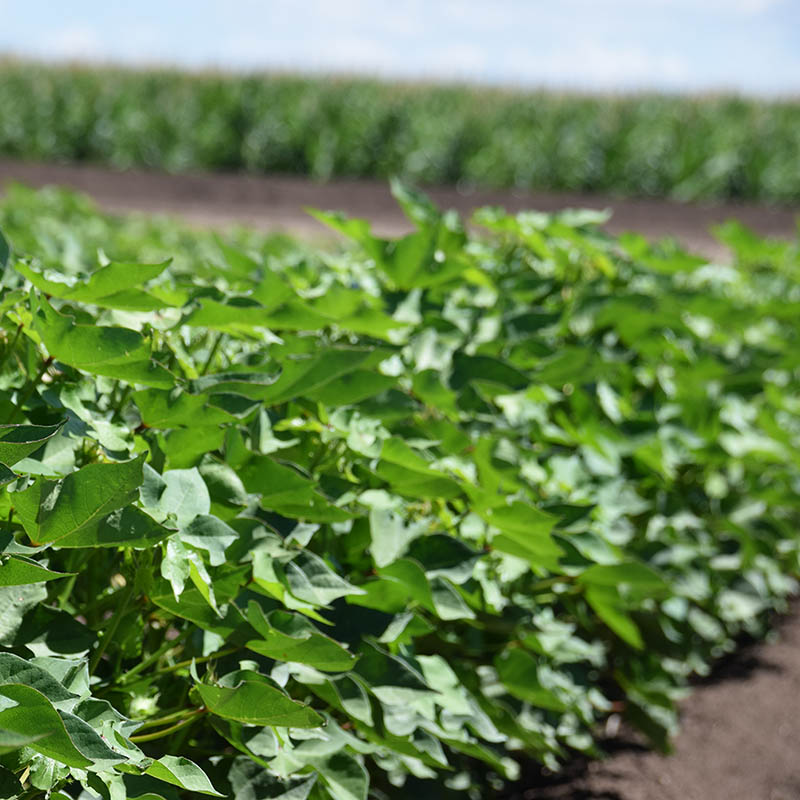
Summer Crop
Power up cotton with petiole testing
December / 2024
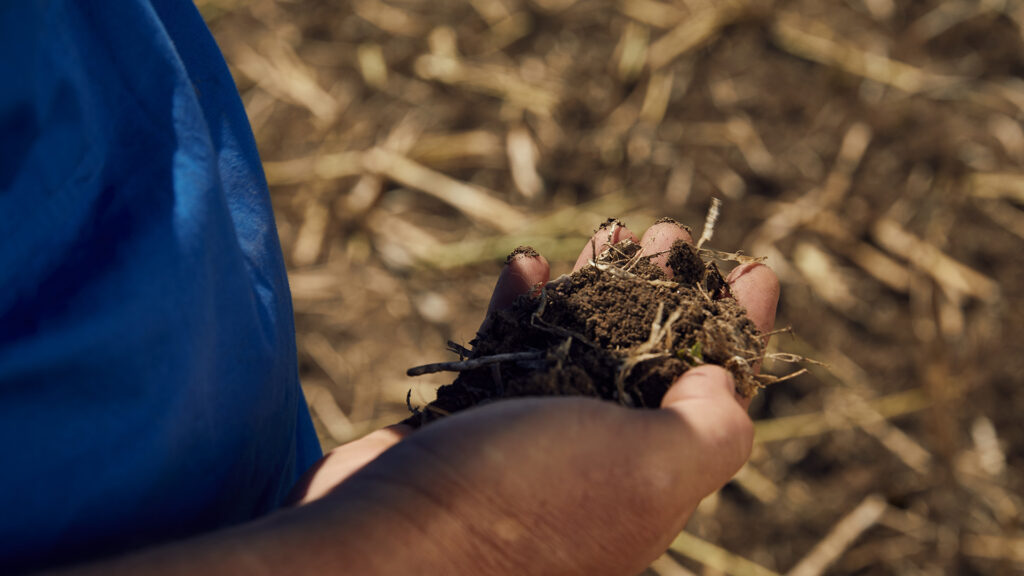
Horticulture, Pasture, Summer Crop
At risk of nitrogen volatilisation? Test your soil before choosing a fertiliser product when broadcasting
February / 2023

Summer Crop
Phosphorus and Zinc: Key to establishing crops
September / 2023

Summer Crop
Prevent nitrogen loss: Test your soil before broadcasting
February / 2025

